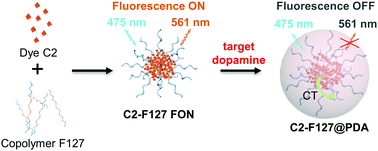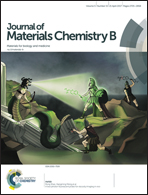Novel fluorescent organic nanoparticles as a label-free biosensor for dopamine in serum†
Abstract
Novel fluorescent organic nanoparticles (FONs) composed of an arbitrarily selected organic dye (C2) and an amphiphilic triblock copolymer (Pluronic F127) have been designed and constructed. The as-prepared C2-F127 FONs display uniform morphology with a diameter of around 300 nm and strong orange fluorescence with an emission maximum at 561 nm. When C2-F127 FONs are utilized as a fluorescent probe for detecting dopamine, a significant fluorescence quenching can be observed. Such fluorescence quenching is attributed to the formation of polydopamine coated on the surfaces of the FONs, which leads to photo-induced charge transfer between the organic dye molecules and the formed polydopamine. Moreover, C2-F127 FONs are highly selective to dopamine over other biomaterials, such as glucose, uric acid, ascorbic acid, epinephrine and L-DOPA, including in a competitive environment. As C2-F127 FONs demonstrate good dispersion and high stability in biological media, they are further utilized as a label-free biosensor for detecting dopamine in 10% serum, and satisfactory sensitivity and selectivity are achieved.



 Please wait while we load your content...
Please wait while we load your content...